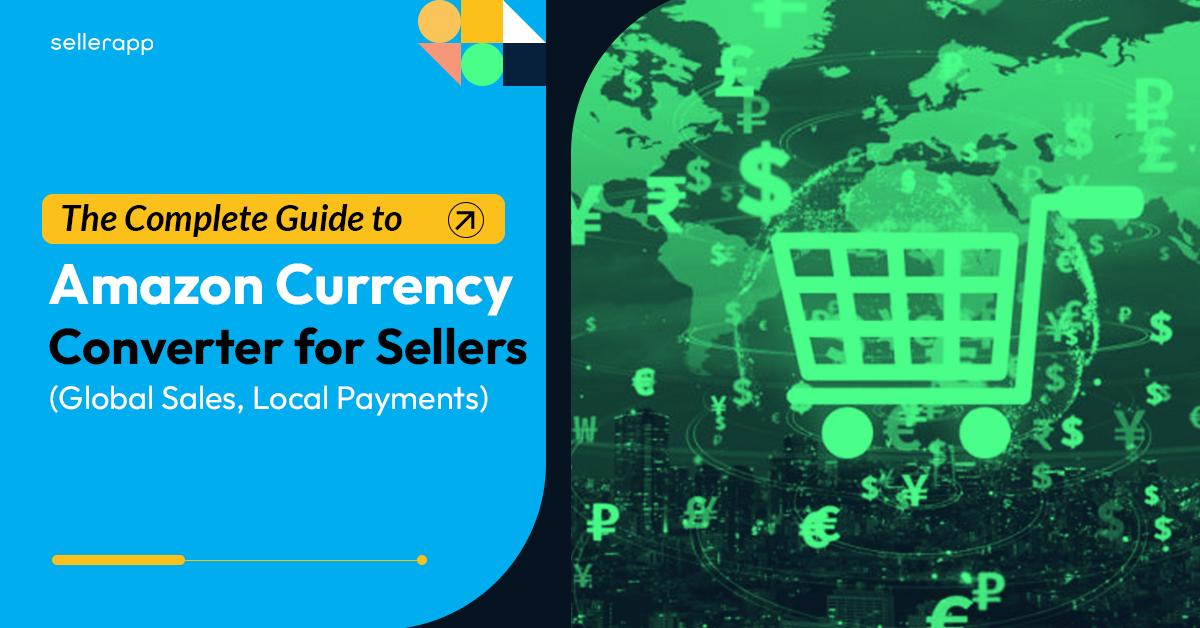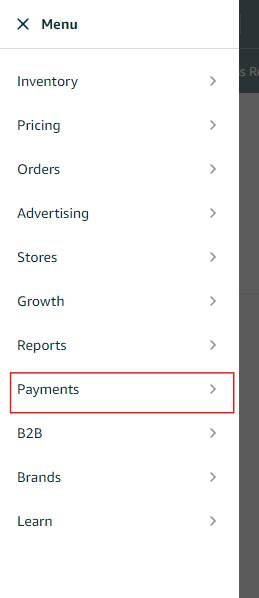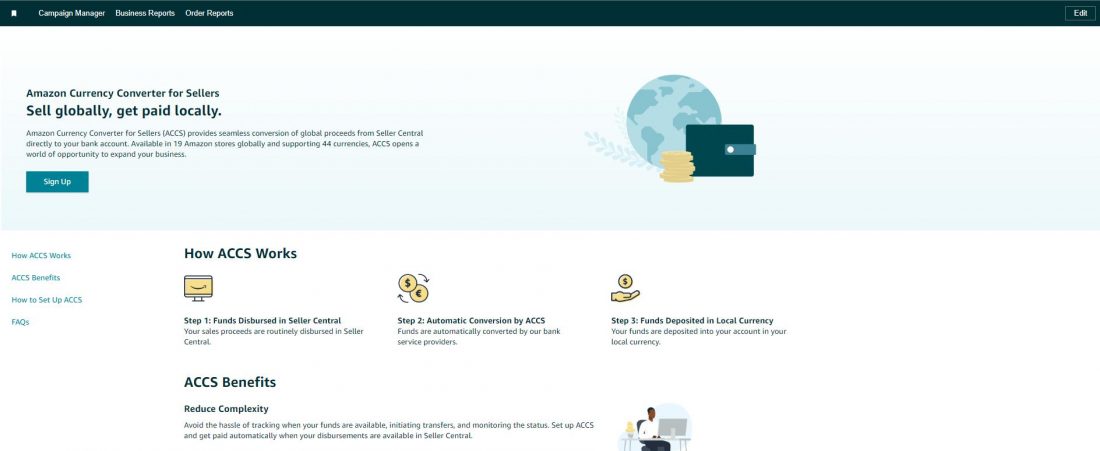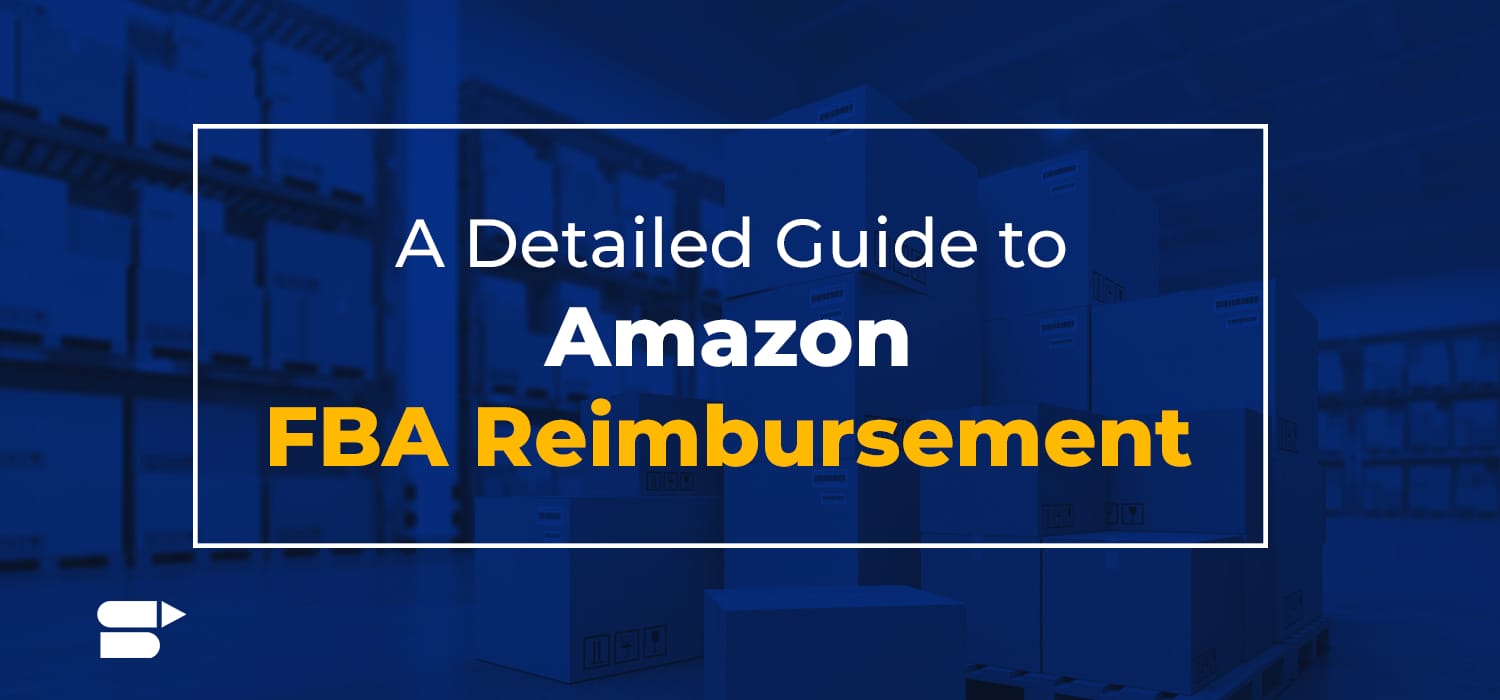Amazon Currency Converter for Sellers: Streamlining Global Transactions

Amazon Sellers often sell products to customers from various countries and deal with multiple currencies. Now, managing these transactions without a tool like Amazon Currency can be a time-consuming task.
Especially, when it comes to currency conversions and reconciling accounts. This is where Amazon’s Currency Converter comes into play.
This powerful tool is designed to streamline the process of handling multi-currency transactions, enabling sellers to focus on growing their businesses while Amazon takes care of the intricate details of currency conversions.
By leveraging Amazon currency converter rates and integrated conversion services, sellers can minimize any issues associated with selling globally and maximize their profitability.
In this article, we’ll delve into the inner workings of this cool tool and dive into how it can help you.
What is Amazon Currency Converter for Sellers (ACCS)?
Amazon Currency Converter for Sellers (ACCS) is a service provided by Amazon that simplifies the process of receiving payments in various currencies for sellers who operate globally. ACCS automates the currency conversion process, eliminating the need for sellers to maintain multiple bank accounts across different regions and manually calculate fluctuating exchange rates.
Once the specified terms have been agreed to and all bank information has been properly entered, payments will automatically be transferred to the seller’s chosen bank account. Money will be deposited in the current currency of the country of the bank account.
Payments will be made regularly and will not be delayed or interrupted because of the international transfer protocol. Note that adding or changing bank account information can delay transfers of payments for up to fourteen days.
How Does the Amazon currency converter for sellers (ACCS) Work?
Amazon Currency Converter is a tool/feature provided by Amazon to help sellers who operate in multiple marketplaces deal with international transactions.
When a buyer places an order on a different Amazon marketplace, the order amount is commonly displayed in the local currency of that marketplace. However, by enabling the ACCS, Amazon will convert the order amount into the seller’s payout currency or the currency in which the seller will be paid, using applicable exchange rates.
This process makes it super convenient for sellers to sell and scale in foreign marketplaces.
As for the exchange rates, Amazon tends to use highly competitive exchange rates that are updated regularly based on market conditions. However, from having assisted thousands of sellers, we’ve found that Amazon’s exchange rate isn’t necessarily the best deal.
There are payment providers like Wise that may actually provide a better deal than the Amazon seller currency converter. Ultimately, you’ll have to research based on your requirements. But more on that later.
Sellers can choose their payout currency from a list of eligible currencies provided by Amazon. This is the currency in which the seller will receive their disbursements (payments) from Amazon.
Now, what’s in it for Amazon? Well, Amazon charges a small currency conversion fee for each order that requires a currency conversion. This fee covers the cost of providing the currency conversion service and is typically a percentage of the total order amount being converted.
When it comes to invoicing and reporting, using the Amazon seller currency converter will make the reconciliation process much easier. All invoices and reports provided to sellers display the original order amount in the local currency of the marketplace, as well as the converted amount in the seller’s payout currency.
This transparency will allow you to easily reconcile their accounts and understand the impact of currency conversions on their sales.
How to find hidden fees in Amazon currency converter?
Fundamentally, there are no “hidden fees” with the Amazon currency converter. You won’t be subjected to any foreign exchange fees. However, this doesn’t mean that there aren’t any fees.
Amazon uses a volume-based fee (VBF) to determine how much a seller is charged.
This is essentially calculated by the number of sales completed over the past 12 months, known as the Total Processed Volume (TPV). Of course, this is extremely transparent.
Here’s the Amazon currency converter fees:
0.75% fee for revenue equal to or greater than $10 million
1.00% fee for revenue equal to or greater than $1 million
1.25% fee for revenue equal to or greater than $500,000
1.50% fee for revenue equal to or greater than $100,000
This means the more you sell, the less you’ll have to pay. It’s important to note that while these Amazon currency converter fees are transparent and are seemingly low, they can stack up over time. Meaning, if you’re moving $10,000 a month, you’d have to spend $150 only on these fees. In addition to all of the other fees, it can be a significant chunk of your time.
Meaning, it’s important to also note that you may not necessarily get a good deal from a traditional bank or from ACCS.
Ultimately, you have to shop around until you zero in on what makes sense for your business. You actually have to break down the fees and calculate them to figure out how much you’re going to have to pay.
How do I activate Amazon currency converter?
Activating the Amazon currency converter is fairly simple all you have to do is follow these steps:
- Start by logging into your Seller Central account on Amazon
- Now, head to the payments tab on the left-hand side menu section.

- In payout settings, scroll down to “Currency Converter”

- Finally, sign up for the ACCS program.
By following these steps, you will be able to activate the Amazon currency converter and manage your transactions in your preferred currency.
The Pros and Cons of Amazon Currency Converter for Sellers
Here are the pros and cons of Amazon Currency Converter for Sellers:
Pros:
- The ACCS is built into Amazon Seller Central. So, there’s no need for any need to set anything else up such as a payment provider.
- Funds are seamlessly paid out in your local currency to your local bank account.
- You also have better control over your finances because it’s a native feature.
- There is also no need for manual calculations as ACCS automates the conversion process, reducing the need for manual calculations, and minimizing errors.
- All the fees are transparent so you don’t have to worry about any unethical practices.
- The ease of conversion is the primary benefit of using the ACCS. You can manage international transactions by converting payments from the customer’s local currency to your preferred currency.
Cons:
- Although Amazon currency converter rates are competitive, fluctuations in the final rate exchange rates can still significantly affect you as this is a volume-based business. Yes, even though there are volume-based deductions, you still will lose on a chunk that can be either reinvested in inventory or in PPC.
- Similarly, refunds are also processed using fluctuating exchange rates can lead to a hole-in-the-bucket type of situation that can result in considerable losses. Moreover, you also have limited control over the refund process and may not be able to adjust for exchange rate fluctuations.
- While it is relatively easy to use the Amazon currency converter calculator, it can still be complicated for sellers to manage. Especially if they don’t have experience managing international transactions.
Amazon Currency Converter Supported Countries
Amazon Currency Converter for Sellers (ACCS) is supported by 19 Amazon marketplace stores and allows for payouts in 44 currencies. It is important to note that only certain countries are eligible for Amazon accounts. Bank accounts from within these countries can easily use the Amazon Currency Converter Services.
Here’s a full list of all the supported currencies:
Albania (ALL)
Argentina (ARS)
Bangladesh (BDT)
Brazil (BRL)
Bulgaria (BGN)
Cambodia (KHR)
Canada, Canadian Dollars (CAD)
China (CNY)
Colombia (COP)
Croatia (HRK)
Czech Republic (CZK)
Denmark (DKK)
European Zone, Euros (EUR)
Hungary (HUF)
Hong Kong (HKD)
Indonesia (IDR)
Israel (ILS)
Jordan (JOD)
Japan (JPY)
Laos (LAK)
Malaysia (MYR)
Mexico (MXN)
Morocco (MAD)
Nepal (NPR)
New Zealand (NZD)
Nigeria (NGN)
Norway (NOK)
Pakistan (PKR)
Poland (PLN)
Philippines (PHP)
Romania (RON)
South Korea (KRW)
Sri Lanka (LKR)
Sweden (SEK)
Singapore (SGD)
South Africa (ZAR)
Switzerland and Lichtenstein (CHF)
Taiwan (TWD)
Thailand (THB)
United States (USD)
United Arab Emirates (AED)
Vietnam (VND)
What documentation do you need?
Amazon is extremely stringent when it comes to documentation and since you’d be selling on the platform, it’s best to ensure that there are no compliance issues.
We recommend that all sellers inquire and adhere to any local taxation laws.
Therefore, depending on the country of registration you will have to gather all the necessary documentation. This will fluctuate, therefore, we cannot give you specifics. It’s best to talk to a certified accountant or a lawyer in the country of your registration for specific details.
Of course, ACCS is for sellers who sell globally but want to get paid locally. Therefore, all of the money is sent to your local bank account.
So, in a situation where you have a bank account in your country of residence and have registered another bank account in the country of registration, you’ll have to turn off the bank account in the country of registration and activate ACCS for the local bank account.
Additionally, any sales and transaction documentation from Amazon will be rendered in the currency of the marketplace in which the goods were sold. For example, items sold on www.Amazon.com will be documented in US dollars.
How do refunds work for Amazon Currency Converter Accounts?
Refunds are made in the currency of the marketplace and not the currency you’ve chosen. Meaning, if you’re selling on Amazon.com, you’ll be paid in USD.
As for the exchange rate, this will be the same exchange rate that was used during the purchase.
Amazon, brilliantly, locks the exchange rate at the time of purchase and mentions the rate in the payment total. Therefore, you won’t lose out on any money due to this same guaranteed rate.
Additional read: Amazon Seller Repay: Charges, Customer Service, and Refund
Is Amazon currency converter worth it?
The Amazon currency converter for sellers (ACCS) is worth it. Without the currency converter, you will be subjected to the exchange rate of the day. Additionally, your bank will also have hidden fees which can take a chunk of your profits.
Most importantly, when you have to deal with returns, the fluctuating exchange rates imposed by the bank can result in a hole-in-bucket situation where you will run into significant losses over time.
Final Thoughts
Ultimately, using the Amazon Currency Converter for Sellers (ACCS) can limit a ton of guesswork and help you reconcile.
Even though there are volume-based fees involved with using this converter, it can be a better option than using bank cards or payment providers with hidden fees. However, you will, ultimately, need to figure out what makes sense for your business.
Of course, we recommend using our free sales estimator and our FBA Calculator to understand your product’s profitability and then choose whether to enable the ACCS or use a payment provider.
Additional read:
How to earn 3% more on each sale internationally









